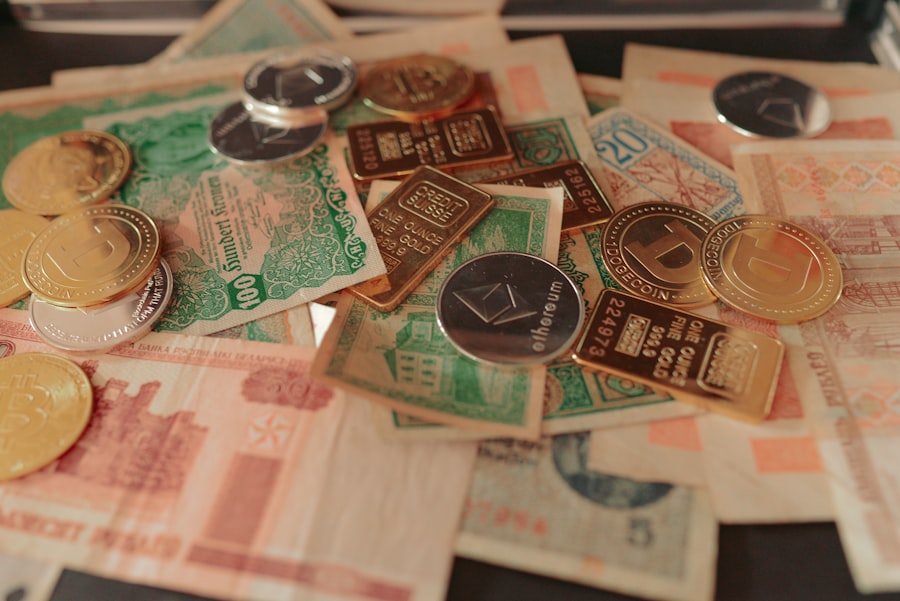Dollar devaluation refers to a decrease in the value of the U.S. dollar relative to other currencies or assets. This phenomenon can occur due to various factors, including inflation, changes in interest rates, and shifts in economic policy.
As the dollar loses value, purchasing power diminishes, meaning that you will need more dollars to buy the same goods and services. This can lead to increased costs of living and can significantly impact your financial planning and investment strategies. When the dollar devalues, it can create a ripple effect throughout the economy.
For instance, imported goods become more expensive, which can lead to inflationary pressures. As a result, you may find that your savings are eroded over time if they are not invested wisely. Understanding the dynamics of dollar devaluation is crucial for making informed decisions about how to protect and grow your wealth in an uncertain economic landscape.
Key Takeaways
- Dollar devaluation can lead to a decrease in the purchasing power of the currency, making it important to consider alternative investments.
- Gold is often seen as a hedge against inflation and currency devaluation due to its historical stability and value retention.
- Real estate offers a tangible investment with the potential for long-term appreciation and the ability to generate rental income.
- Cryptocurrency provides a digital store of value that can offer diversification and potential for high returns, but comes with higher volatility and risk.
- Historical performance shows that gold has often performed well during periods of dollar devaluation, making it a popular choice for investors seeking to protect their wealth.
The Appeal of Gold as a Hedge
Gold has long been regarded as a safe haven asset, particularly during times of economic uncertainty and dollar devaluation. Its intrinsic value and historical significance make it an attractive option for those looking to hedge against inflation and currency fluctuations. When the dollar weakens, gold often appreciates in value, providing a buffer for your investments.
This inverse relationship between gold and the dollar can be a powerful tool in your financial arsenal. Moreover, gold is a tangible asset that you can physically hold, unlike stocks or bonds. This physicality can provide a sense of security, especially during turbulent economic times.
You may find comfort in knowing that your investment is not subject to the same risks as digital assets or fiat currencies. Additionally, gold has a long history of maintaining its value over time, making it a reliable choice for preserving wealth across generations.
Real Estate: A Tangible Investment

Real estate is another tangible investment that can serve as a hedge against dollar devaluation. Unlike cash or stocks, real estate tends to appreciate over time, often outpacing inflation. When the dollar loses value, property values may rise as demand for tangible assets increases.
Investing in real estate allows you to own a physical asset that can generate rental income and appreciate in value, providing you with both cash flow and long-term growth potential. Furthermore, real estate offers tax advantages that can enhance your overall return on investment. Deductions for mortgage interest and property taxes can reduce your taxable income, allowing you to keep more of your earnings.
Additionally, real estate can act as a hedge against inflation; as prices rise, so too do rents and property values. This makes real estate an appealing option for those looking to secure their financial future in an environment of dollar devaluation.
Cryptocurrency: A Digital Store of Value
| Metrics | Data |
|---|---|
| Market Cap | 2.5 trillion |
| Bitcoin Dominance | 40% |
| Number of Cryptocurrencies | over 10,000 |
| 24-hour Trading Volume | 200 billion |
| Bitcoin Price | 50,000 |
Cryptocurrency has emerged as a modern alternative to traditional assets like gold and real estate. As a decentralized digital currency, it offers unique advantages in a devaluing dollar environment. Many view cryptocurrencies like Bitcoin as a store of value similar to gold, especially given their limited supply and increasing adoption.
As confidence in fiat currencies wanes, you may find that cryptocurrencies provide an innovative way to diversify your portfolio and protect your wealth. However, investing in cryptocurrency comes with its own set of challenges. The market is known for its volatility, which can lead to significant price fluctuations in short periods.
While this volatility presents opportunities for high returns, it also poses risks that you must carefully consider. Understanding the technology behind cryptocurrencies and staying informed about market trends will be essential if you choose to explore this digital frontier.
Historical Performance of Gold During Dollar Devaluation
Historically, gold has demonstrated resilience during periods of dollar devaluation. For instance, during the 1970s, when inflation surged and the dollar weakened significantly, gold prices skyrocketed. Investors who had allocated a portion of their portfolios to gold were able to preserve their wealth while others faced declining purchasing power.
This historical performance reinforces the idea that gold can serve as a reliable hedge against economic instability. Moreover, gold’s performance during financial crises further solidifies its status as a safe haven asset. In times of uncertainty—such as the 2008 financial crisis—gold prices often rise as investors flock to its perceived safety.
By examining these historical trends, you can gain valuable insights into how gold may perform in future economic downturns and consider how it fits into your overall investment strategy.
Real Estate as a Long-Term Investment

Real estate is often viewed as a long-term investment due to its potential for appreciation and income generation over time. Unlike stocks or bonds that can be subject to market fluctuations, real estate tends to provide stability and consistent returns when held over extended periods. As you consider your investment options, it’s essential to recognize that real estate can serve as both a hedge against inflation and a source of passive income.
Additionally, real estate investments can be leveraged through financing options such as mortgages. This means you can control a more significant asset with less capital upfront, potentially amplifying your returns when property values increase. By holding onto real estate for the long term, you may benefit from both appreciation and rental income while mitigating risks associated with short-term market volatility.
Volatility and Potential of Cryptocurrency in a Devaluing Dollar Environment
Cryptocurrency’s volatility presents both opportunities and challenges in a devaluing dollar environment. On one hand, the potential for rapid price increases can lead to substantial gains for investors willing to navigate the risks. As traditional currencies lose value, cryptocurrencies may gain traction as alternative stores of value, attracting new investors seeking refuge from inflationary pressures.
On the other hand, this volatility means that you must approach cryptocurrency investments with caution. Prices can swing dramatically based on market sentiment, regulatory news, or technological developments. To successfully invest in cryptocurrencies during periods of dollar devaluation, it’s crucial to stay informed about market trends and developments while maintaining a diversified portfolio that includes more stable assets.
Diversifying Your Portfolio with Gold, Real Estate, and Cryptocurrency
Diversification is key to managing risk in any investment strategy. By incorporating gold, real estate, and cryptocurrency into your portfolio, you can create a balanced approach that mitigates potential losses while maximizing growth opportunities. Each asset class offers unique benefits; gold provides stability and protection against inflation, real estate offers long-term appreciation and income potential, while cryptocurrency presents opportunities for high returns despite its inherent risks.
When diversifying your portfolio, consider your risk tolerance and investment goals. Allocating different percentages of your portfolio to each asset class allows you to tailor your investments according to your financial objectives. For instance, if you’re more risk-averse, you might allocate a larger portion to gold and real estate while keeping a smaller percentage in cryptocurrency for growth potential.
Risks and Considerations for Investing in Gold, Real Estate, and Cryptocurrency
While investing in gold, real estate, and cryptocurrency offers numerous benefits, it’s essential to be aware of the associated risks. Gold prices can be influenced by various factors such as interest rates, geopolitical events, and changes in investor sentiment. Similarly, real estate markets can fluctuate based on local economic conditions and housing demand.
Cryptocurrency carries its own unique set of risks due to its relatively nascent market structure and regulatory uncertainties. Prices can be highly volatile, leading to potential losses if you’re not prepared for sudden downturns.
Additionally, security concerns surrounding digital wallets and exchanges must be taken into account when investing in cryptocurrencies.
The Role of Government Policies in Dollar Devaluation and Asset Performance
Government policies play a significant role in influencing dollar devaluation and the performance of various assets. Monetary policy decisions made by the Federal Reserve—such as interest rate adjustments—can directly impact the value of the dollar and subsequently affect asset prices across the board. For instance, low-interest rates may lead to increased borrowing and spending but could also contribute to inflationary pressures that devalue the dollar.
Additionally, fiscal policies such as government spending and taxation can influence economic growth and stability. Understanding how these policies affect the broader economic landscape will help you make more informed investment decisions regarding gold, real estate, and cryptocurrency during periods of dollar devaluation.
Strategies for Protecting Your Wealth in a Devaluing Dollar Economy
To protect your wealth in a devaluing dollar economy, consider implementing several strategies that leverage the strengths of gold, real estate, and cryptocurrency. First and foremost, allocate a portion of your portfolio to gold as a hedge against inflation and currency fluctuations. This allocation can provide stability during turbulent economic times.
Next, consider investing in real estate for its potential appreciation and income generation capabilities. Rental properties or real estate investment trusts (REITs) can offer consistent cash flow while also serving as a hedge against inflation. Finally, if you’re comfortable with higher risk levels, explore cryptocurrency investments for their growth potential in an evolving financial landscape.
By diversifying across these asset classes and staying informed about market trends and government policies, you can develop a robust strategy for protecting your wealth against the challenges posed by dollar devaluation. In conclusion, understanding dollar devaluation is crucial for making informed investment decisions that protect your wealth over time. By considering gold, real estate, and cryptocurrency as part of your diversified portfolio strategy, you can navigate economic uncertainties with greater confidence while positioning yourself for long-term financial success.
In times of economic uncertainty, understanding how to protect your wealth against dollar devaluation becomes crucial. One insightful article that delves into the best assets to consider during such periods can be found on Real Lore and Order. This article provides a comprehensive analysis of various investment options, including precious metals, real estate, and foreign currencies, which can serve as a hedge against the declining value of the dollar. For more detailed information, you can read the full article by visiting this link.
WATCH THIS! The 8 Assets You OWN But the Government CONTROLS (Dollar Collapse Survival)
FAQs
What are the best assets for dollar devaluation?
The best assets for dollar devaluation are typically those that retain their value or even appreciate in value when the dollar weakens. These can include precious metals, foreign currencies, real estate in strong markets, and certain types of stocks and bonds.
Why are precious metals considered a good asset for dollar devaluation?
Precious metals like gold and silver are considered a good asset for dollar devaluation because they have historically retained their value and even appreciated during times of currency devaluation. They are seen as a hedge against inflation and currency fluctuations.
What are some examples of foreign currencies that can be good assets for dollar devaluation?
Examples of foreign currencies that can be good assets for dollar devaluation include the Swiss franc, the Japanese yen, the Euro, and the British pound. These currencies are often seen as stable and can provide a hedge against a weakening dollar.
Why is real estate in strong markets considered a good asset for dollar devaluation?
Real estate in strong markets is considered a good asset for dollar devaluation because it can retain its value and even appreciate when the dollar weakens. In strong markets, real estate tends to be in high demand and can provide a stable investment during times of currency devaluation.
What types of stocks and bonds are considered good assets for dollar devaluation?
Certain types of stocks and bonds, such as those in companies with strong international exposure or those that pay dividends in foreign currencies, can be considered good assets for dollar devaluation. These investments can provide a hedge against a weakening dollar and may even benefit from currency fluctuations.
